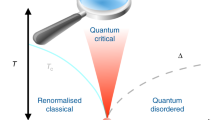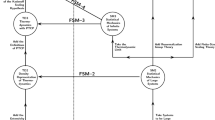Abstract
An overview is given of the long-time and long-distance behavior of correlation functions in both classical and quantum statistical mechanics. After a simple derivation of the classical long-time tails in equilibrium time correlation functions, we discuss analogous long-distance phenomena in nonequilibrium classical systems. The paper then draws analogies between these phenomena and similar effects in quantum statistical mechanics, with emphasis on the soft modes that underly long-time tails and related phenomena. We also elucidate the interplay between critical phenomena and long-time tails, using the classical liquid-gas critical point and the quantum ferromagnetic transition as examples.
Similar content being viewed by others
REFERENCES
B. J. Alder and T. E. Wainwright, Phys. Rev. A 1:18 (1970).
J. R. Dorfman and E. G. D. Cohen, Phys. Rev. Lett. 25:1257 (1970).
M. H. Ernst, E. H. Hauge, and J. M. J. van Leeuwen, Phys. Rev. Lett. 25:1254 (1970).
W. W. Wood and J. J. Erpenbeck, Annu. Rev. Phys. Chem. 27:331 (1975).
J. R. Dorfman, Physica A 106:77 (1981).
J. R. Dorfman, T. R. Kirkpatrick, and J. V. Sengers, Annu. Rev. Phys. Chem. 45:213 (1994).
D. Forster, D. R. Nelson, and M. J. Stephen, Phys. Rev. A 16:732 (1977), and references therein.
See, e.g., J. P. Boon and S. Yip, Molecular Hydrodynamics (Dover, New York, 1980).
H. E. Stanley, Introduction to Phase Transitions and Critical Phenomena (Oxford University Press, Oxford, 1971).
M. E. Fisher, in Advanced Course on Critical Phenomena, F. W. Hahne, ed. (Springer, Berlin, 1983), p. 1.
P. C. Hohenberg and B. I. Halperin, Rev. Mod. Phys. 49:435 (1977).
S. Nagel, Rev. Mod. Phys. 64:321 (1992).
J. V. Sengers, in Critical Phenomena, NBS Miscellaneous Publ., M. S. Green and J. V. Sengers, eds. (U.S. Gov't Printing Office, Washington, DC, 1966).
M. Fixman, Adv. Chem. Phys. 6:175 (1964); J. Chem. Phys. 47:2808 (1967).
L. P. Kadanoff and J. Swift, Phys. Rev. 166:89 (1968).
K. Kawasaki, Phys. Rev. 150:291 (1966); Ann. Phys. 61:1 (1970).
Most of these developments in the theory of quantum many-body systems were put in a language that makes analogies to classical LTT effects far from obvious, although early work in this area did stress the connection with classical statistical mechanics, J. S. Langer and T. Neal, Phys. Rev. Lett. 16:984 (1966). Part of our motivation in the present paper is to elucidate the hidden close relation between these phenomena.
E. Abrahams, P. W. Anderson, D. C. Licciardello, and T. V. Ramakrishnan, Phys. Rev. Lett. 42:673 (1979).
See, e.g., J. W. Negele and H. Orland, Quantum Many-Particle Systems (Addison-Wesley, New York, 1988).
Historically,the term “weak localization”was first used for the transport properties ofnoninteracting disordered electrons in two-dimensions.It is now often used in the broadermeaning of LTT and GSI phenomena in fermion systems,with or without interactions,inany dimensionality.For reviews,see,P.A.Lee and T.V.Ramakrishnan,Rev.Mod.Phys.57 :287 (1985);B.L.Altshuler and A.G.Aronov,in Electron-Electron Interactions in Dis-ordered Systems ,M.Pollak and A.L.Efros,eds.(North-Holland,Amsterdam,1984),p.1.
P. W. Anderson, Phys. Rev. 109:1492 (1958).
N. F. Mott, Metal-Insulator Transitions (Taylor & Francis, London, 1990).
D. Belitz and T. R. Kirkpatrick, Rev. Mod. Phys. 66:261 (1994).
S. Sachdev, Quantum Phase Transitions (Cambridge University Press, Cambridge, 1999).
S. L. Sondhi, S. M. Girvin, and J. P. Carini, Rev. Mod. Phys. 69:315 (1997).
T. R. Kirkpatrick and D. Belitz, in Electron Correlation in the Solid State, N. H. March, ed. (Imperial College Press, London, 1999).
L. D. Landau and E. M. Lifshitz, Fluid Mechanics (Pergamon, London, 1959), ch. 17; D. Ronis, I. Procaccia, and J. Machta, Phys. Rev. A 22:714 (1980).
S. Chandrasekhar, Hydrodynamic and Hydromagnetic Stability (Oxford University Press, Oxford, 1961).
D. Forster, Hydrodynamic Fluctuations, Broken Symmetry, and Correlation Functions (Benjamin, Reading, MA, 1975).
M. H. Ernst, E. H. Hauge, and J. M. J. van Leeuwen, J. Stat. Phys. 15:7 (1976); ibid. 15:23 (1976).
K. Kawasaki, in Phase Transitions and Critical Phenomena, Vol. 5a, C. Domb and M. S. Green, eds. (Academic Press, New York, 1976), p. 165.
G. F. Mazenko, S. Ramaswamy, and J. Toner, Phys. Rev. B 28:1618 (1983).
D. Forster, D. R. Nelson, and M. J. Stephen, Ref. 7.
J. Luettner-Strathmann, J. V. Sengers, and G. A. Olchowy, J. Chem. Phys. 103:7482 (1995).
T. Imeada, A. Onuki, and K. Kawasaki, Progr. Theor. Phys. 71:16 (1984).
T. R. Kirkpatrick, E. G. D. Cohen, and J. R. Dorfman, Phys. Rev. A 26:950 (1982), ibid. 26:995 (1982).
R. Schmitz and E. G. D. Cohen, J. Stat. Phys. 40:431 (1985)
J. M. Ortiz de Zarate, R. Perez Cordon, and J. V. Sengers, Physics A 291:113 (2001).
B. M. Law and J. V. Sengers, J. Stat. Phys. 57:531 (1989).
W. B. Li, P. N. Segré, R. W. Gammon, and J. V. Sengers, Physica A 204:399 (1994).
B. M. Law and J. C. Nieuwoudt, Phys. Rev. A 40:3880 (1989).
J. V. Sengers and J. M. Ortiz de Zárate, in Thermal Nonequilibrium Phenomena in Fluid Mixtures, W. Köhler and W. Wiegand, eds. (Springer, Berlin, 2001).
W. B. Li, K. J. Zhang, J. V. Sengers, R. W. Gammon, and J. M. Ortiz de Zárate, Phys. Rev. Lett. 81:5580 (1998); J. Chem. Phys. 112:9139 (2000).
T. Imeada, A. Onuki, and K. Kawasaki, Ref. 37; B. Schmittmann and R. K. P. Zia, in Phase Transitions and Critical Phenomena, Vol. 17, C. Domb and J. L. Lebowitz, eds. (Academic Press, New York, 1995).
See, e.g., D. Belitz, F. Evers, and T. R. Kirkpatrick, Phys. Rev. 58:9710 (1998).
See, e.g., G. Baym and C. Pethick, Landau Fermi-Liquid Theory (Wiley, New York, 1991).
F. Wegner, Z. Phys. B 35:207 (1979).
L. Schäfer and F. Wegner, Z. Phys. B 38:113 (1980).
D. Belitz and T. R. Kirkpatrick, Phys. Rev. B 56:6513 (1997).
L. P. Gorkov, A. I. Larkin, and D. E. Khmelnitskii, Pis'ma Zh. Eksp. Teor. Fiz. 30:248 (1979) [JETP Lett. 30:228 (1979)].
B. L. Altshuler, A. G. Aronov, and P. A. Lee, Phys. Rev. Lett. 44:1288 (1980).
See, e.g., E. H. Hauge, in Transport Phenomena, Lecture Notes in Physics No. 31, G. Kirczenow and J. Marro, eds. (Springer, New York, 1974), p. 337.
M. H. Ernst, J. Machta, H. van Beijeren, and J. R. Dorfman, J. Stat. Phys. 34:477 (1984).
P. Dai, Y. Zhang, and M. P. Sarachik, Phys. Rev. B 45:3984 (1992).
G. J. Dolan and D. D. Osheroff, Phys. Rev. Lett. 43:721 (1979).
T. R. Kirkpatrick and D. Belitz, J. Stat. Phys. 87:1307 (1997).
For noninteracting electrons, there is consensus that this statement is true. Until recently, it was also believed to be true for interacting electrons, but experiments showing an apparent metal-insulator transition in two-dimensional systems have cast doubt on this, see E. Abrahams, S. V. Kravchenko, and M. P. Sarachik, Rev. Mod. Phys. 73:251 (2001). The correct explanation of these observations is still being debated.
T. R. Kirkpatrick and D. Belitz, Phys. Rev. B 53:14364 (1996).
D. Belitz, T. R. Kirkpatrick, and T. Vojta, cond-mat/0109547.
D. Belitz, T. R. Kirkpatrick, and T. Vojta, Phys. Rev. B 55:9452 (1997).
G. Y. Chitov and A. J. Millis, cond-mat/0103155.
C. Pfleiderer, G. J. McMullan, S. R. Julian, and G. G. Lonzarich, Phys. Rev. 55:8330 (1997).
S. S. Saxena et al., Nature 406:587 (2000); A. Huxley et al., Phys. Rev. B 63:144519 (2001).
C. Pfleiderer et al., Nature 412:58 (2001).
See, K. G. Wilson and J. Kogut, Phys. Rep. 12:75 (1974) for the general philosophy underlying this approach. For the application to quantum phase transitions, see J. Hertz, ref. 68, and references therein.
J. Hertz, Phys. Rev. B 14:1165 (1976).
J. Hubbard, Phys. Rev. Lett. 3:77 (1959); R. L. Stratonovich, Dok. Akad. Nauk. SSSR 115:1907 (1957) [Sov. Phys. Dokl. 2:416 (1957)].
D. Belitz, T. R. Kirkpatrick, M. T. Mercaldo, and S. L. Sessions, Phys. Rev. B 63:174427 (2001); ibid. 63:174428 (2001).
D. Belitz, T. R. Kirkpatrick, and T. Vojta, Phys. Rev. Lett. 82:4707 (1999).
T. Vojta, D. Belitz, T. R. Kirkpatrick, and R. Narayanan, Ann. Phys. (Leipzig) 8:593 (1999).
M. Yoshimura and T. R. Kirkpatrick, Phys. Rev. B 54:7109 (1996).
Author information
Authors and Affiliations
Rights and permissions
About this article
Cite this article
Kirkpatrick, T.R., Belitz, D. & Sengers, J.V. Long-Time Tails, Weak Localization, and Classical and Quantum Critical Behavior. Journal of Statistical Physics 109, 373–405 (2002). https://doi.org/10.1023/A:1020485809093
Issue Date:
DOI: https://doi.org/10.1023/A:1020485809093




